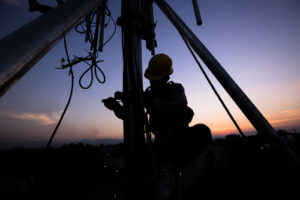 The job for telecommunications tower technicians is a dangerous one under perfect conditions. When conditions are less than ideal, the risks become life-threatening. In January 2019, a tower technician in South Dakota fell to his death during a climb that took place in the evening after dark. The incident caused the industry to ask, “How necessary is nighttime climbing?”
The job for telecommunications tower technicians is a dangerous one under perfect conditions. When conditions are less than ideal, the risks become life-threatening. In January 2019, a tower technician in South Dakota fell to his death during a climb that took place in the evening after dark. The incident caused the industry to ask, “How necessary is nighttime climbing?”
Climbs at night have a much higher risk than those that take place in daylight for some obvious reasons. Visibility is limited making it difficult to see if you’re tied off correctly, to identify high-voltage lines properly, and to determine where to step safely. It also makes it hard for ground workers to keep an eye on the tower technicians in case of emergency.
Does this mean nighttime work can’t be done safely? Not necessarily. But in order to limit risk and keep workers safe, the two main challenges for nighttime climbs must be addressed—fatigue and preparation.
FATIGUE
One of the problems facing nighttime workers is fatigue. Sometimes workers who are on the job at night were also on the job for several hours during the day. If a worker doesn’t get enough fuel (food and hydration) or sleep, they may not be in the proper condition for the job. When they are worn-out, it can lead to a higher chance of an incident occurring. It’s best to assign night work only to those workers who did not work heavy hours during the day as well. Also, keep an eye on employees to make sure are up for the job at hand. If they show signs that they are not alert and well rested, assign someone else.
PREPARATION
In order to reduce risks and make sure night work is done as safely as possible, preparation is key. The team should inspect the tower when it is light out. Workers should get familiar with it and make sure to mitigate any potential risks ahead of time. All gear should be inspected prior to the job and confirmed to be in tip-top shape without any tears or sign of wear that might compromise safety.
A rescue plan should also be in place. Workers need a way to communicate and see one another. Not only does the tower need to be lit up but workers should wear high-quality headlamps. Glow sticks are helpful in keeping the workers visible to one another. Workers should have two-way radios on them and a backup method for communication, such as a whistle system.
It is important to make sure not to rush. Nighttime work requires more time, and that should be given to workers without question. Being rushed could put them at greater risk of an accident.
For risk management best practices, always start with the team. Those chosen for night work should be well trained in doing this type of work. They should be well versed in safety and the extra steps that need to be taken for nighttime climbs.
If you’re going to take on nighttime work, make sure to take the extra steps necessary to keep workers safe. There are many things that can go wrong, but proper preparation along with trained, skilled, and well-rested employees can greatly reduce the risk.

